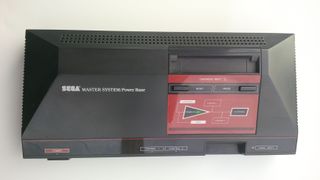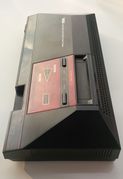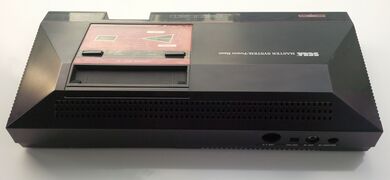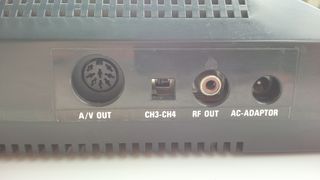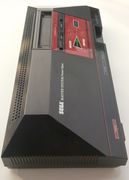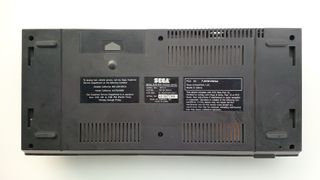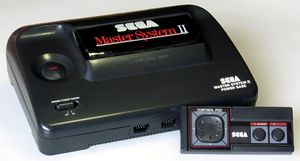Sega Master System
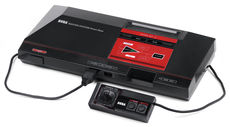
| |
| Manufacturer | SEGA |
|---|---|
| Generation | Third generation |
| Release date | October 20, 1985 (JP) (Mark III) June 1986 (NA) September 1987 (EU) October 18, 1987 (JP)(Master System) |
| Media type | ROM cartridge and Sega Card |
| Predecessor | SG-1000 |
| Successor | Sega Mega Drive/Genesis |
The Master System, often called the Sega Master System or SMS, is a third-generation video game console that was manufactured and released by Sega in 1985 in Japan (as the Sega Mark III), 1986 in North America, 1987 in Europe and 1989 in Brazil.
The original Master System could play both cartridges and the credit card-sized "Sega Cards," which retailed for cheaper prices than cartridges but had lower storage capacity. The Master System also featured accessories such as a light gun and 3D glasses which were designed to work with a range of specially coded games.
The Master System was released as a direct competitor to the Nintendo Entertainment System in the third videogame generation. The Master System was technically superior to the NES, which predated its release by nine months in North America but failed to overturn Nintendo's significant market share advantage in Japan and North America.
Contents
Technical Specifications[edit]
- CPU: 8-bit Zilog Z80 at 3.58 MHz (3.579545 MHz)
- Memory: 64 kbits (8 KB)
- Storage capacity: Sega Card (256 kbits max. capacity)
- Display NTSC or PAL based on the TMS9918 video chip
- Ports: 2 controller ports + 1 expansion slot
Peripherals[edit]
- Controller 3 (2 buttons, hole for screw-in thumb stick)
- Controller 4 (6 buttons, very similar to the Mega Drive's 6 button pad; released in Brazil only)
- Control Stick (2 buttons and a stick similar to a gear stick, but on the right side and the buttons are on the left side)
- Light Phaser (light gun)
- Sega Remote Control System
- Sega Sports Pad (trackball controller)
- Sega Handle Controller (steering wheel controller for driving-/airplane games)
- SG Commander (standard controller with built-in rapid fire)
- SegaScope 3-D Glasses (the glasses can only be used in the original Master System, since it hooks up directly to the card port not found in the Master System II. This system allows 3-D graphics in full color. The technology takes advantage of the interlaced video output of CRT TV's, displaying the left image in the top field and the right image in the bottom field. Only eight Master System games are 3-D compatible.)
Variations of the SMS[edit]
Mark III[edit]
- The Mark III was built similarly to the SG-1000 II, with the addition of improved video hardware and an increased amount of RAM.
- The system was backwards compatible with earlier SG-1000 titles. As well as the standard cartridge slot, it had a built-in slot, formerly known as expansion slot for Sega My Cards, which were physically identical to the cards for the Sega SG-1000 "Card Catcher" add-on. While in Japan there were many titles in this format published for both the SG-1000 and Mark III, only a few were published in the West.
Master System II[edit]
- The Master System II was released in 1990, and was popular in Europe and Brazil. It is smaller and sleeker, but in order to keep production costs low, it lacks the reset button, composite video and card slot of the original. All consoles included a game that plays when no cartridge is inserted. The built-in game was originally Alex Kidd in Miracle World, which was switched to Sonic the Hedgehog on later PAL consoles.
- There are two variants of the Master System II - black with a black pause button, and grey with a white pause button - there is no other difference between the two. The former is more common in PAL regions, and was never sold in North America.
Service manual can be downloaded here.
- Power: 9V 600mA
Master System III[edit]
- A newer variant of the Master System II was released by Sega's Brazilian distributor Tectoy. Named the Master System III in Brazil this new version is mostly identical to the previous Master System II builds, except that the color scheme was changed from the traditional dark color scheme predominantly Black/Grey from the older releases, to a lighter blue and white scheme, the Master System control pads were replaced with the Mega Drive 6-button pads, and now the console has 74 or 105 built-in games.
Master System Evolution[edit]
- The latest version, released in 2009 by Tectoy, is the "Master System Evolution", as a successor to "Master System III". It is a "console on a chip", a similar design to its antecessor but with 1 more game, a total of 132 built-in Sega Master System games. It ships with two six button controllers and two different colors of the console exist.
